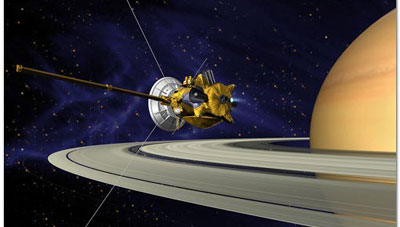Cassini-Huygens: the last battlestarby Taylor Dinerman
|
| This time, instead of simply passing by, Cassini will go into orbit for a minimum four-year mission. With any luck, it will last twice that long. |
At the time of its launch, the whole mission was subject to some intense protests by antinuclear activists. It was claimed that the plutonium-equipped radioisotope thermoelectric generator (RTG) that provides Cassini with its electrical power might come apart in an accident and contaminate the earth. After the successful launch, the same group said that each time the probe swung by our planet, it threatened to somehow dissolve in the upper atmosphere with catastrophic consequences. In spite of all the evidence and the thorough testing data that NASA and its contractors made available, much of the media gave credence to the protesters.
The other problem that the Cassini managers have faced is the failure of someone to take into account the radio frequency Doppler shift that the Huygens probe will experience on its way down to the surface of Titan. Saturn’s fifteenth moon, a little less than 1.5 million kilometers from the planet, will be the main subject of the mission’s investigations. NASA and the European Space Agency, which built Huygens, have come up with a modified flight path that will, along with some minor adjustments to the probe, fix this problem. Clever use of celestial mechanics to fix mission problems has to be characteristic of JPL over the years (Mars Global Surveyor, for example.) It’s nice to note that they have not lost this essential skill.
Already, the information and imagery from Saturn’s moon, Phoebe, has given us a small foretaste of the feast to come. Existing astronomy textbooks will, no doubt, have to be rewritten several times over the duration of Cassini’s explorations. Cassini-Huygens may be the last of the conventional “battlestar” deep space missions but, already, Project Prometheus is developing the nuclear propelled and powered Jupiter Icy Moon Orbiter (JIMO) which, if successful, will be the first of a fleet of large nuclear spacecraft that will carry arrays of high powered science instruments throughout the solar system and, perhaps, beyond.
| The lesson for NASA is that this should be the last mission that demands a lifetime of professional commitment. |
With their relatively restricted budgets, NASA’s space scientists and their international partners have, since the 1970s, opened up a golden age of robotic planetary exploration. They have lots more to do before humans go out beyond the orbit of the moon. Given the current ways of doing things, it takes about twenty years for missions such as Cassini to be designed, launched, and have it arrive at its destination. The goal of Prometheus is to reduce the travel time, using nuclear propulsion, and to insure that when a mission arrives it has plenty of electric power. The reforms proposed by both the administrator and the Aldridge Commission should have the effect of reducing that time frame as much as possible.
A number of scientists have staked their whole careers on the success of this mission. They will be keeping their fingers crossed until sometime on July 1st, when they will know if the dangerous 94-minute engine burn has gone as planned. Once it is safely in orbit around the ringed planet, the spacecraft can begin to do its real work. The lesson for NASA is that this should be the last mission that demands a lifetime of professional commitment.
